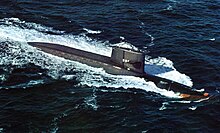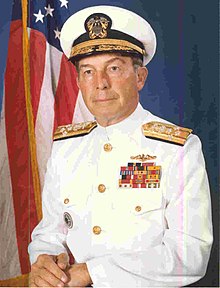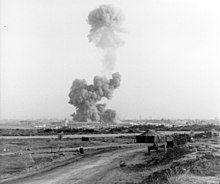Robert LJ Long
Robert "Bob" Lyman John Long (* 29. May 1920 in Kansas City , Missouri ; † 28. June 2002 in Bethesda , Maryland ) was an American admiral of the US Navy , which between 1977 and 1979 Vice Chief of Naval Operations and from 1979 to 1983 was Commander of the US Pacific Command .
During the tenure of US President Ronald Reagan , he was appointed by the President to investigate the attack on the US base in Beirut on October 23, 1983 , in which a total of 299 soldiers and 6 civilians, including 241 US soldiers, were killed.
Life
Military training, World War II and post-war period
After attending Paseo High School and Kansas City Junior College in 1940, Long began his military training at the US Naval Academy in Annapolis , which he served as a naval lieutenant in 1943 after the United States entered World War II after the attack on Pearl Harbor on December 7, 1941 by the Imperial Japanese Naval Air Force completed the shortened three-year course early.
He was then used on the battleship USS Colorado and took part in the Pacific War. For his local military merits in combat against the Imperial Japanese Navy in the Battle of the Philippine Sea in June 1944 and the Battle of Okinawa from April to June 1945, he was awarded the Bronze Star with the addition Combat V excellent.
After the end of World War II , Long completed additional training at the submarine school and temporarily lectured in the Naval Reserve Officer Training Unit at the University of North Carolina at Chapel Hill . After various posts in the submarine associations and graduating from Naval War College in Newport in 1954, he took over his first command of a ship, namely the Tench-class submarine USS Sea Leopard . In 1959 he became an officer on the staff of Vice Admiral Hyman Rickover , who is considered the father of the US nuclear navy.
The Polaris project

After Commander Long had completed a training course for the nuclear program of the US Navy, he became in 1960 one of the commanders of the USS Patrick Henry , one of George Washington-class submarine belonging nuclear-powered submarines with ballistic missiles . He was in command of the so-called "golden (second) crew" (Gold Crew) , which alternated with the "blue (first) crew" (Blue Crew) commanded by Harold E. Shear , the staff for the USS Patrick Henry , which was the case with the Nuclear submarines was common to increase the underwater use of these units.
In August 1963, Captain Long first commander of the USS Casimir Pulaski , a to James Madison belonging class submarine that with medium-range missiles of the type -27 UGM Polaris was equipped, so ' Submarine-launched ballistic missiles ' (SLBM) were . The USS Casimir Pulaski officially entered service on August 14, 1964. This time he was in command of the first (blue) crew, while the second (gold) crew was commanded by Frigate Captain Thomas B. Brittain, Jr.
Adjutant to the Vice Secretary of the Navy and flag officer
After completing his assignment as commanding officer of the USS Casimir Pulaski , Long became Executive Assistant and Naval Aide to the then Vice Secretary of the Navy Robert HB Baldwin in August 1966 and remained in this position For two years also with his successor Charles F. Baird until August 1968. For the services there he was awarded the Legion of Merit for the first time in February 1969 .
After serving in the Navy Department ( US Department of the Navy ) in 1968 his promotion was made to Rear Admiral . As such, he was in command of Service Group Three , which acted as a task force (Task Force 73) . He then became Deputy Commander for fleet maintenance and logistical support (Deputy Commander for Fleet Maintenance and Logistic Support) of the ship's system command of the US Navy ( Naval Ship Systems Command ) .
In June 1972 Long was appointed Vice Admiral promoted and took over as such the position as commander of the submarine associations (Submarine Force) of the US Atlantic Fleet ( US Atlantic Fleet ) , before 1974 deputy chief of naval operations for submarine warfare (Deputy Chief of Naval Operations for Submarine Warfare) .

In July 1977. Long received his promotion to admiral and was to succeed Admiral Harold E. Shear, in turn, Supreme Commander of Allied Forces Southern Europe (AFSOUTH) of NATO was the function as Vice Chief of Naval Operations (VCNO) and held in order to the Chief of Naval Operations, the second highest position in the leadership of the US Navy. He held this office until April 1979 and was then replaced by Admiral James D. Watkins . Because of his services in this role, he was honored with the Navy Distinguished Service Medal and another Legion of Merit, which was instead awarded to him as a gold star for his first Legion of Merit.
Subsequently, on October 31, 1979, Admiral Long succeeded Maurice F. Weisner as Commander-in-Chief of the US Pacific Command (USPACOM), the inter -armed regional command of the US armed forces responsible for the Pacific and Southeast Asian regions .
After the end of General David C. Jones's tenure as Chairman of the Joint Chiefs of Staff on June 18, 1982, Long was considered his possible successor. However, President Reagan chose to appoint General John W. Vessey, Jr. as Chairman of the United Chiefs of Staff. Long remained instead commander of USPACOM until his retirement from active military service and was on 1 July 1983 by Admiral William J. Crowe Jr. replaced. For his achievements in this function he was again honored with the Navy Distinguished Service Medal and another Legion of Merit, which was instead awarded to him as the second gold star for his first Legion of Merit.
The attack on the US base in Beirut in 1983
After the attack on the US base in Beirut on October 23, 1983, in which a total of 299 soldiers and 6 civilians, including 241 US soldiers, were killed, Long was led by US President Ronald Reagan and Defense Secretary Caspar Weinberger along with four other employees by the US Department of Defense to investigate the attack. The commission of inquiry questioned US officers in Washington, DC , Europe and Lebanon about why the US Marine Corps facility in Beirut was not better guarded so that a terrorist could drive a truck loaded with explosives into the military facility .
On December 28, 1983, the commission of inquiry, chaired by Long, presented its final report. Previously, President Reagan had already stated that the facility's local commanders should not be punished for inadequately securing the US Marines. Long told Defense Secretary Weinberger that he did not consider criminal charges against the officers in charge of the US Navy necessary, but that other consequences should not be ruled out.
Long later served as president of the US Naval Academy's Alumni Association from 1991 to 1994 .
Awards
Web links
- MAN IN THE NEWS; ADMIRAL WHO ASKED THE QUESTIONS . In: The New York Times, December 29, 1983
- Adm. Robert Long, 82, Leader Of Inquiry in '83 Terrorist Attack . In: The New York Times, July 3, 2002
- Academy Graduate Serves 40 Years in the Submarine Force, Leaves Historic Legacy
- Entry in the Hall of Valor of the Military Times
- Robert LJ Long in the database of Find a Grave (English)
Individual evidence
- ↑ PENTAGON ORDERS BEIRUT INQUIRY . In: The New York Times, October 30, 1983
| personal data | |
|---|---|
| SURNAME | Long, Robert LJ |
| ALTERNATIVE NAMES | Long, Robert Lyman John (full name); Bob Long (nickname) |
| BRIEF DESCRIPTION | American admiral in the US Navy |
| DATE OF BIRTH | May 29, 1920 |
| PLACE OF BIRTH | Kansas City , Missouri |
| DATE OF DEATH | June 28, 2002 |
| Place of death | Bethesda , Maryland |


